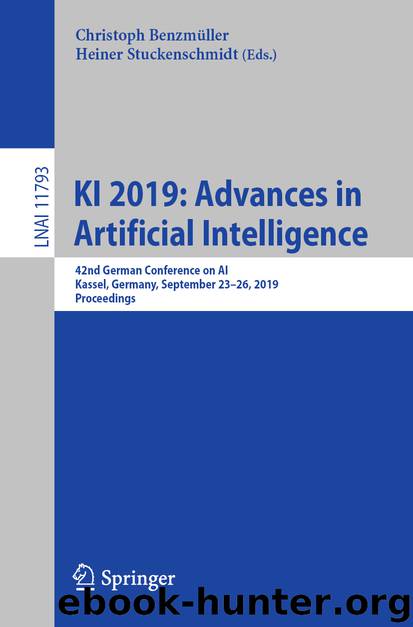KI 2019: Advances in Artificial Intelligence by Christoph Benzmüller & Heiner Stuckenschmidt

Author:Christoph Benzmüller & Heiner Stuckenschmidt
Language: eng
Format: epub
ISBN: 9783030301798
Publisher: Springer International Publishing
2.1 Movement Segmentation
The learning platform allows for learning complex skills which cannot be learned monolithically. By splitting complex movements into simpler sub-tasks, learning of these tasks becomes feasible. Previously learned sub-tasks can be reused in other related tasks. In the learning platform, this process is automatized using the segmentation and classification approach presented in [8]. Human manipulation movements follow a characteristic bell-shaped velocity pattern of the hand [13]. We use these bell-shaped profiles to identify building blocks of manipulation movements using an unsupervised segmentation algorithm, called velocity-based Multiple Change-point Inference (vMCI), introduced in [18]. To generate labels for the identified movement building blocks, we use a supervised approach based on 1-Nearest Neighbor (1-NN) classification. By transforming recorded trajectories of several positions of the demonstrator’s arm to a coordinate frame relative to the back of the human, and interpolating the identified segments to the same length, simple 1-NN classification shows good classification results on several manipulation tasks with small training set sizes [7, 8]. Using the unsupervised movement segmentation algorithm vMCI in combination with 1-NN classification, the relevant movement parts of the demonstrations that shall be learned by the system can be selected. Benefits of the approach are that the movements can be performed naturally by the demonstrator, and no manual segmentation procedure is required. Furthermore, the same approach works for different manipulation movement without the need for adaptations. This has already been evaluated on ball-throwing and pick-and-place movements in our previous work [6, 8]. In this work, we additionally evaluate this approach on a bigger dataset, containing approximately 700 stick-throwing demonstrations.
Download
This site does not store any files on its server. We only index and link to content provided by other sites. Please contact the content providers to delete copyright contents if any and email us, we'll remove relevant links or contents immediately.
Algorithms of the Intelligent Web by Haralambos Marmanis;Dmitry Babenko(8523)
Test-Driven Development with Java by Alan Mellor(7427)
Data Augmentation with Python by Duc Haba(7317)
Principles of Data Fabric by Sonia Mezzetta(7065)
Learn Blender Simulations the Right Way by Stephen Pearson(7006)
Microservices with Spring Boot 3 and Spring Cloud by Magnus Larsson(6825)
RPA Solution Architect's Handbook by Sachin Sahgal(6234)
Hadoop in Practice by Alex Holmes(6032)
The Infinite Retina by Robert Scoble Irena Cronin(5935)
Jquery UI in Action : Master the concepts Of Jquery UI: A Step By Step Approach by ANMOL GOYAL(5873)
Big Data Analysis with Python by Ivan Marin(5732)
Life 3.0: Being Human in the Age of Artificial Intelligence by Tegmark Max(5405)
Pretrain Vision and Large Language Models in Python by Emily Webber(4693)
Infrastructure as Code for Beginners by Russ McKendrick(4471)
WordPress Plugin Development Cookbook by Yannick Lefebvre(4204)
Functional Programming in JavaScript by Mantyla Dan(4124)
The Age of Surveillance Capitalism by Shoshana Zuboff(4118)
Embracing Microservices Design by Ovais Mehboob Ahmed Khan Nabil Siddiqui and Timothy Oleson(3995)
Applied Machine Learning for Healthcare and Life Sciences Using AWS by Ujjwal Ratan(3972)
